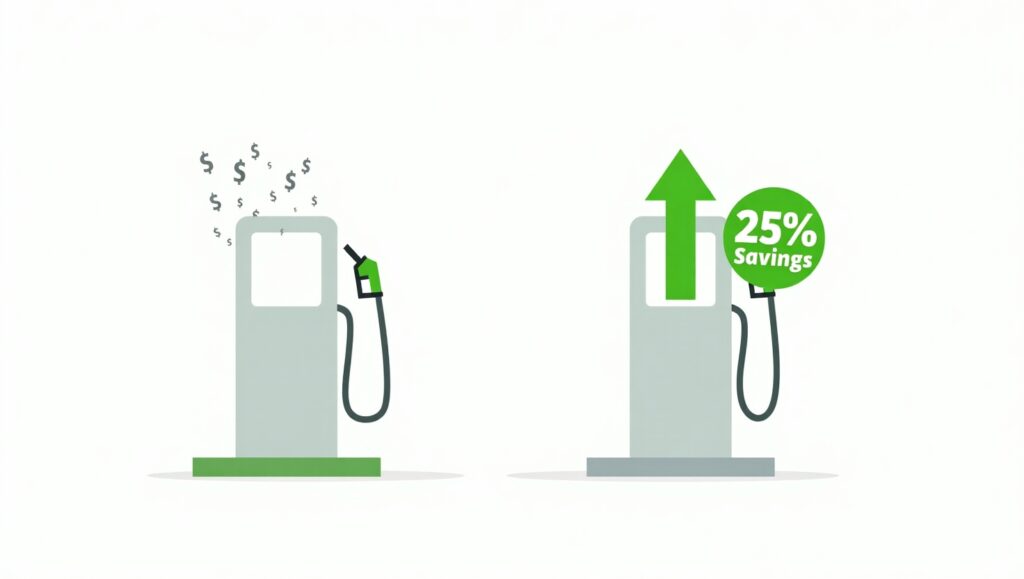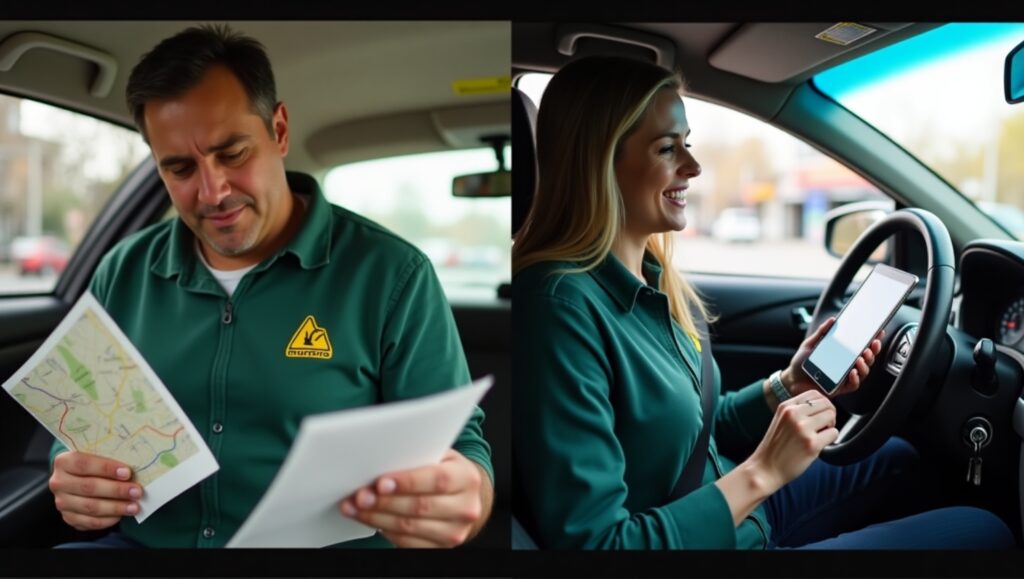Introduction – The Hidden Costs of Inefficient Dispatch Systems
Running a taxi business isn’t just about having cars on the road—it’s about getting them where they need to be, fast. Yet, many fleets lose up to 30% of their revenue simply because of outdated or inefficient taxi dispatch software.
Think about it:
- Drivers circling aimlessly, burning fuel.
- Passengers waiting longer than necessary, leading to poor reviews.
- Dispatchers overwhelmed with manual coordination, making errors.
The right taxi dispatch system doesn’t just assign rides—it optimizes every part of your operation, from route planning to driver management. And with advancements in AI-powered taxi dispatch algorithms and real-time GPS tracking, modern solutions are transforming how taxi businesses compete in 2025.
Table of Contents
Why This Matters Now More Than Ever
The ride-hailing industry is evolving rapidly. With Uber and Lyft setting high customer expectations, independent taxi companies need automated dispatch solutions that keep up. Whether you’re a small fleet or a large operator, inefficiencies in Taxi dispatching can mean:
✔ Lost revenue from idle drivers and inefficient routes.
✔ Higher operational costs due to wasted fuel and time.
✔ Customer churn because of slow pickups and unreliable service.
In this guide, we’ll break down the five biggest problems taxi businesses face—and how the latest taxi booking software solves them. By the end, you’ll see exactly how upgrading your taxi dispatch system can cut costs, boost efficiency, and keep passengers coming back.
Problem #1: Driver Idle Time – How AI-Optimized Routing Puts Your Fleet to Work
Picture this: one of your drivers is sitting in a parking lot, waiting for a taxi dispatch. Meanwhile, just three blocks away, a customer is searching for a ride. Without smart taxi dispatch software, this mismatch happens all the time—costing you money and frustrating drivers. Research from MIT’s Mobility Initiative shows AI dispatch systems reduce idle time by up to 30% in urban fleets
Why Idle Time is a Silent Profit Killer
Every minute a taxi isn’t moving, it’s:
- Burning fuel (and your budget)
- Losing potential fares
- Hurting driver morale (no one likes unpaid downtime)
Traditional dispatch methods rely on guesswork. But modern automated taxi dispatch systems use AI-powered algorithms to:
✔ Predict demand spikes (like rush hour or events)
✔ Assign the closest driver in real-time
✔ Adjust routes dynamically based on traffic

Real-World Savings: A Case Study
A New York taxi company using AI route optimization reduced idle time by 22% in just three months. That meant:
- $8,000+ saved annually per vehicle on fuel
- 15% more daily rides for drivers
- Higher customer ratings (faster pickups = happier passengers)
Simple Fixes You Can Implement Now
Even if you’re not ready for full AI adoption, you can:
- Enable live traffic updates in your current dispatch software
- Cluster bookings in high-demand zones instead of scattering drivers
- Analyze idle time reports weekly to spot inefficiencies
“Before we upgraded our system, our drivers wasted 3+ hours daily just waiting. Now? They’re earning 30% more.”
— Michael R., Fleet Manager, Chicago
Problem #2: Long Passenger Wait Times – How Smart Dispatch Keeps Customers Happy
Nothing loses riders faster than watching their app count up from “2 minutes away” to “7 minutes… and still waiting.” In today’s on-demand economy, passengers expect Uber-level speed—even from local taxi services.
Why Wait Times Make or Break Your Business
- 78% of passengers will abandon a booking if the ETA jumps unexpectedly
- Each 1-star review from a frustrated rider can cost 5+ future bookings
- Competitors with faster taxi dispatch systems steal your regulars
How Top Dispatch Software Solves This
Modern taxi dispatch solutions use three smart strategies:
- Live Demand Heat Mapping
- Spots ride request clusters in real-time
- Pre-positions drivers in busy areas before requests come in
- Example: A Toronto fleet reduced average wait times from 9 to 3 minutes using this
- Surge Prediction
- Learns your city’s patterns (bar closing times, concert venues, etc.)
- Automatically alerts drivers before demand spikes
- Priority Dispatching
- Flags your best/most profitable customers for faster pickup
- Rewards frequent riders with loyalty perks

Quick Wins While You Upgrade
If you’re still using basic dispatch tools:
✔ Set geofence alerts for your busiest zones
✔ Train dispatchers to manually cluster nearby bookings
✔ Add wait time transparency in your app (“Your driver is completing a ride 2 blocks away”)
“After implementing dynamic taxi dispatch, our ‘on-time’ rating jumped from 68% to 94% in 60 days.”
— Sarah L., Operations Director, Miami
Want to ensure 24/7 support for your dispatch system? Explore our customer service outsourcing solutions for taxi businesses.
Problem #3: Sky-High Fuel Costs – How Smarter Routing Puts Money Back in Your Pocket
Let’s talk about the silent budget killer every taxi owner hates: fuel waste. Did you know the average taxi burns 15-30% more fuel due to inefficient routes? That’s thousands yearly—just vanishing in traffic jams and wrong turns. The U.S. Department of Energy reports route optimization can improve fuel efficiency by 15-20%
Where Your Fuel Actually Goes
🚗 Circling for parking near busy pickup spots
🚗 Taking “fastest routes” that aren’t actually fuel-efficient
🚗 Idling in traffic because dispatchers can’t see real-time congestion
How Dispatch Tech Slashes Fuel Bills
Modern systems tackle this three ways:
- AI-Optimized Routes
- Doesn’t just find the fastest route—finds the cheapest one
- Learns patterns (e.g., avoids left turns across busy streets)
- Example: A Chicago fleet saved 340 gallons/month with this
- Traffic Prediction
- Checks live data + historical patterns (like stadium events)
- Reroutes drivers before they hit jams
- Eco-Driving Alerts
- Gentle nudge when drivers accelerate/brake too hard
- Small habit changes = 5-12% better mileage

Quick Fixes While You Upgrade
✔ Group nearby pickups manually (even 2-3 rides clustered helps)
✔ Train drivers to avoid known congestion hotspots
✔ Track weekly fuel use per vehicle—spot gas-guzzlers fast
“We cut our fuel costs by $1,800/month just by letting the software handle routing. Drivers complained at first—until they saw their earnings rise.”
— Diego M., Fleet Owner, Houston
Problem #4: Scaling Your Business – How Dispatch Software Grows With Your Fleet
Hitting a growth ceiling? Many taxi companies discover their manual systems simply can’t handle adding more cars or expanding to new cities. This is where intelligent dispatch software becomes your secret weapon for stress-free scaling.
The Scaling Roadblocks You Might Face
- Taxi Dispatch Chaos
- Adding 10+ vehicles often overwhelms manual systems
- Dispatchers struggle with “Who’s closest?” math for large fleets
- Service Quality Drops
- More cars ≠ better service if coordination fails
- Drivers start competing for the best fares
- City Expansion Headaches
- New regulations, unfamiliar zones, different demand patterns
How Smart taxi Dispatch Handles Growth
For Medium Fleets (10-50 cars):
- Automatic Zone Balancing – Software evenly distributes drivers across neighborhoods
- Driver Tiering – Your top performers get first access to premium jobs
- Shift Scheduling – AI predicts exactly how many drivers each shift needs
For Large Fleets (50+ cars):
- Multi-City Management – Single dashboard for different locations
- Dynamic Pricing – Automatically adjusts rates across zones
- Fleet Analytics – Spots underperforming vehicles/drivers
Real Growth Example:
A London black cab company grew from 12 to 87 vehicles in 18 months by:
✔ Using automated driver assignment to maintain 4-minute response times
✔ Implementing city-specific pricing rules when expanding to Manchester
✔ Monitoring real-time fleet KPIs to identify bottlenecks
Scaling Tips for Any Size Fleet
- Start with cloud-based software (no server limitations)
- Look for systems with multi-language support if expanding internationally
- Always test new markets with a small vehicle group first

“Our dispatch system handled adding 30 new cars last quarter without hiring extra staff. That’s the power of automation.”
— Raj P., Fleet Owner, Birmingham
New to software transitions? Our customer service outsourcing guide breaks down staff training strategies.
Problem #5: Data Security & Compliance – Protecting Your Business in the Digital Age
As taxi businesses go digital, data security becomes just as critical as fuel efficiency. One breach could expose customer payment details, driver records, or your entire dispatch system. Modern taxi dispatch software doesn’t just move cars—it safeguards your business.
The Hidden Risks of Outdated Systems
🚨 Payment Data Vulnerabilities – Unencrypted credit card info invites fraud
🚨 Driver Identity Theft – Fake accounts can infiltrate your fleet
🚨 Regulatory Fines – GDPR, local taxi laws, and PCI compliance violations
How Secure Dispatch Software Protects You
1. API Security (The Technical Shield)
Modern systems use:
- OAuth 2.0 Authentication – Ensures only authorized apps connect
- End-to-End Encryption – Scrambles data from booking to payment
- Webhook Verification – Validates real-time data exchanges
Example: When your dispatch software integrates with payment gateways (like Stripe or PayPal), secure APIs ensure:
✔ Tokenized transactions (no raw card numbers stored)
✔ Automatic PCI-DSS compliance
✔ Fraud detection alerts
2. Compliance Automation
- GDPR/KYC Compliance – Auto-purges old rider data per privacy laws
- Driver Document Tracking – Alerts when licenses/insurance expire
- Audit Logs – Tracks every system change for investigations
3. Emergency Protocols
- SOS Button Integration – Direct panic alerts to local authorities
- Ride Recording – Encrypted audio/video logs for dispute resolution
Real-World Impact: A Near-Miss Story
A Madrid taxi cooperative avoided a €250,000 GDPR fine because their dispatch software:
✔ Automatically anonymized old trip data
✔ Flagged an unauthorized third-party app trying to access their API
✔ Provided compliance reports in one click

Actionable Security Upgrades
Even if you’re not tech-savvy:
- Ask vendors about their SOC 2 or ISO 27001 certifications
- Enable two-factor authentication for all dispatcher logins
- Monthly review who has API access
“After switching to a secure system, our insurance premiums dropped 18%—they recognized we’d eliminated key risks.”
— Lena K., Operations Manager, Berlin
For fleets handling 50+ vehicles (learn how our B2B outsourcing services streamline payroll and compliance).
Final Thoughts: The Future-Proof Taxi Business Starts Here
Running a taxi company in 2025 isn’t about having more cars—it’s about working smarter. Every challenge we’ve covered, from idle drivers to data security, shares one solution: the right dispatch software doesn’t just fix problems—it prevents them.
Your Quick Action Plan
1️⃣ Start Small – Tackle one pain point first (e.g., reduce wait times with heat mapping)
2️⃣ Measure Improvements – Track fuel savings, customer ratings, or driver retention
3️⃣ Scale What Works – Add AI routing or multi-city management as you grow

The Bottom Line
The taxi operators thriving today aren’t just using technology—they’re letting it rethink their entire business. Whether you’re upgrading from pen-and-paper dispatch or switching from an outdated system, remember:
“A modern dispatch solution pays for itself within months—in fuel savings alone.”
Discover how our end-to-end taxi dispatch services integrate AI routing with driver management tools.
Ready to transform your fleet? Get our free checklist comparing top taxi dispatch software features.




Pingback: In-House vs Outsourcing: The Ultimate Decision Guide